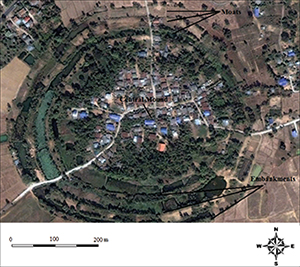Crossref Citations
This article has been cited by the following publications. This list is generated based on data provided by
Crossref.
Wohlfarth, Barbara
Higham, Charles
Yamoah, Kweku Afrifa
Chabangborn, Akkaneewut
Chawchai, Sakonvan
and
Smittenberg, Rienk H
2016.
Human adaptation to mid- to late-Holocene climate change in Northeast Thailand.
The Holocene,
Vol. 26,
Issue. 11,
p.
1875.
Yamoah, Kweku Afrifa
Higham, Charles FW
Wohlfarth, Barbara
Chabangborn, Akkaneewut
Chawchai, Sakonvan
Schenk, Frederik
and
Smittenberg, Rienk H
2017.
Societal response to monsoonal fluctuations in NE Thailand during the demise of Angkor Civilisation.
The Holocene,
Vol. 27,
Issue. 10,
p.
1455.
King, Charlotte L.
Halcrow, Siân E.
Tayles, Nancy
and
Shkrum, Stephanie
2017.
Considering the palaeoepidemiological implications of socioeconomic and environmental change in Southeast Asia.
Archaeological Research in Asia,
Vol. 11,
Issue. ,
p.
27.
Dhavale, Neha
Halcrow, Siân E.
Buckley, Hallie R.
Tayles, Nancy
Domett, Kate M.
and
Gray, Andrew R.
2017.
Linear and appositional growth in infants and children from the prehistoric settlement of Ban Non Wat, Northeast Thailand: Evaluating biological responses to agricultural intensification in Southeast Asia.
Journal of Archaeological Science: Reports,
Vol. 11,
Issue. ,
p.
435.
O'Reilly, Dougald
Evans, Damian
and
Shewan, Louise
2017.
Airborne LiDAR prospection at Lovea, an Iron Age moated settlement in central Cambodia.
Antiquity,
Vol. 91,
Issue. 358,
p.
947.
Scott, Glen
and
O'Reilly, Dougald
2017.
A re-appraisal of the spatial distribution of single and multi-moat prehistoric sites in Northeast Thailand.
Archaeological Research in Asia,
Vol. 11,
Issue. ,
p.
69.
Castillo, Cristina C.
Higham, Charles F.W.
Miller, Katie
Chang, Nigel
Douka, Katerina
Higham, Thomas F.G.
and
Fuller, Dorian Q
2018.
Social responses to climate change in Iron Age north-east Thailand: new archaeobotanical evidence.
Antiquity,
Vol. 92,
Issue. 365,
p.
1274.
Higham, C.F.W.
Manly, B.F.J.
Thosarat, R.
Buckley, H.R.
Chang, N.
Halcrow, S.E.
Ward, S.
O'Reilly, D.J.W.
Shewan, L.G.
and
Domett, K.
2019.
Environmental and Social Change in Northeast Thailand during the Iron Age.
Cambridge Archaeological Journal,
Vol. 29,
Issue. 4,
p.
549.
Chawchai, Sakonvan
Liu, Guangxin
Bissen, Raphael
Scholz, Denis
Riechelmann, Dana F.C.
Vonhof, Hubert
Mertz-Kraus, Regina
Chiang, Hong-Wei
Tan, Liangcheng
and
Wang, Xianfeng
2020.
Hydroclimate variability of western Thailand during the last 1400 years.
Quaternary Science Reviews,
Vol. 241,
Issue. ,
p.
106423.
Yang, Kunhua
and
Han, Guilin
2020.
Controls over hydrogen and oxygen isotopes of surface water and groundwater in the Mun River catchment, northeast Thailand: implications for the water cycle.
Hydrogeology Journal,
Vol. 28,
Issue. 3,
p.
1021.
Thuy, Vo Thi Phuong
Fletcher, Roland J.
and
Liou, Ying-San
2021.
Extensive, low-density Vietnamese urban settlements - 10th to 19th century CE: redefining ancestry and organization in a Southeast Asian urban tradition.
World Archaeology,
Vol. 53,
Issue. 2,
p.
345.
Bamrungkhul, Settawut
and
Tanaka, Takahiro
2022.
Reinterpreting Nirat Nongkhai: an historical account of settlement and land use in north-eastern Thailand during the nineteenth century.
Landscape History,
Vol. 43,
Issue. 1,
p.
69.
Higham, Charles Franklin Wandesforde
and
Kijngam, Amphan
2023.
Zooarchaeology of Ban Chiang and the rise of early farming communities in mainland Southeast Asia.
International Journal of Osteoarchaeology,
Vol. 33,
Issue. 1,
p.
51.
Kim, Nam C.
Trinh, Hiep H.
Quick, Russell
and
Phuong Thuy, Vo Thi
2023.
Co Loa: Biography of an Anomalous Place.
Journal of Urban Archaeology,
Vol. 7,
Issue. ,
p.
51.
Khamsiri, Sutthikan
Venunan, Pira
Khaokheiw, Chawalit
Silapanth, Praon
and
Pailoplee, Santi
2023.
Reconstructing the ancient route network in the Thailand–Cambodia borders: A case study of the Angkorian Royal Road.
Archaeological Prospection,
Vol. 30,
Issue. 3,
p.
357.
Yankowski, Andrea
Chang, Dr. Nigel
and
Kerdsap, Puangtip
2023.
Ethnoarchaeological Study on Salt-Fermented Fish in the Upper Mun River Valley, Northeast Thailand.
Archaeology of Food and Foodways,
Patnukao, Areerut
2024.
Revisiting moated sites in Northeast Thailand: integrating spatial analysis with previous and new research insights.
GeoJournal,
Vol. 89,
Issue. 5,
Srisunthon, Prapawadee
Mueller, Daniela
Wilk, Jakob
and
Preusser, Frank
2024.
Structure and age of ancient walls from the city of Nan, northern Thailand.
Archaeological and Anthropological Sciences,
Vol. 16,
Issue. 5,
Yang, Hong
Wang, Shaohua
Wang, Shunli
Zhao, Pengcheng
Ai, Mingyao
and
Hu, Qingwu
2024.
Moated site object detection using time series satellite imagery and an improved deep learning model in northeast Thailand.
Journal of Archaeological Science,
Vol. 171,
Issue. ,
p.
106070.



